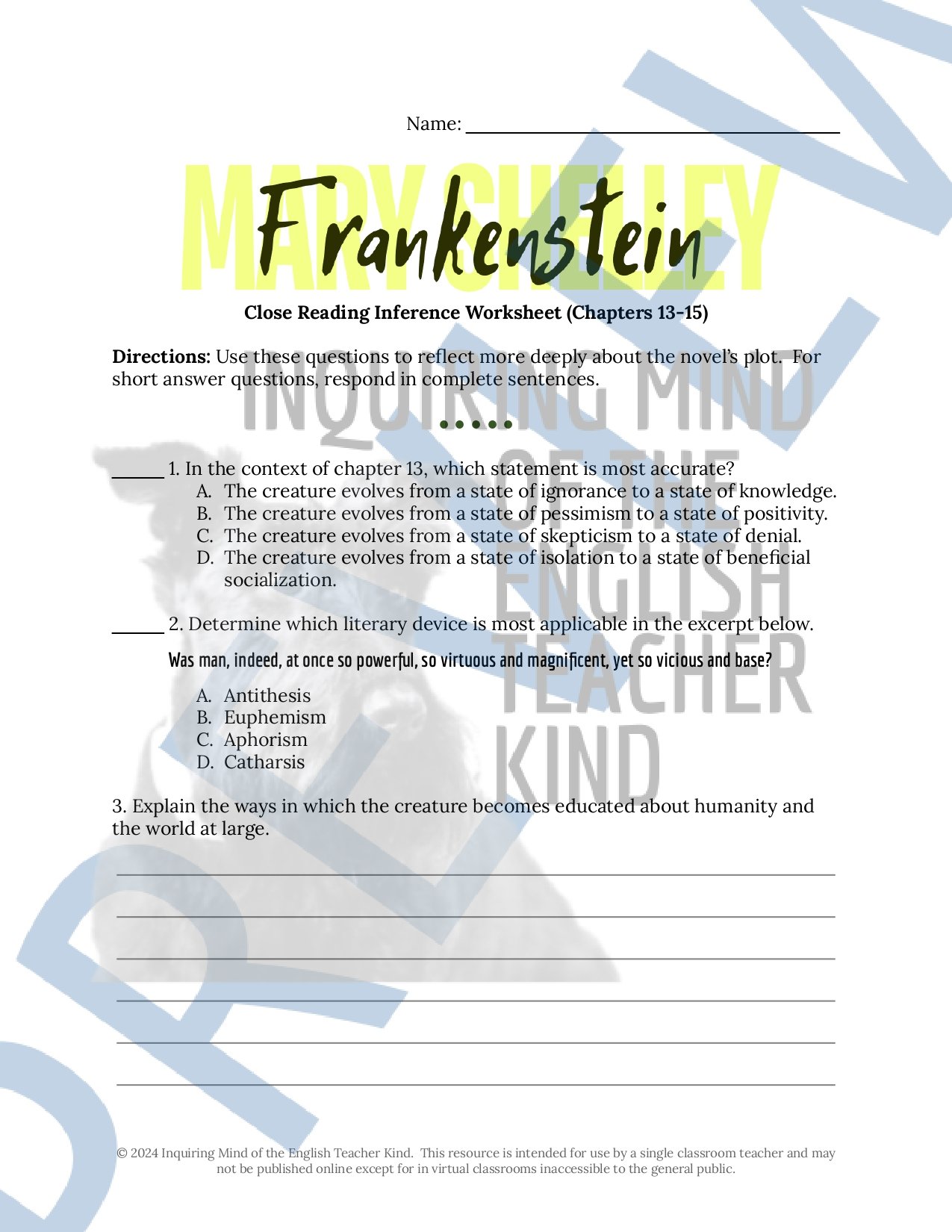Frankenstein Chapters 13-15 Quiz, Close Reading Worksheet, and Vocabulary Games
Facilitate vocabulary development, evaluate reading comprehension, and help students practice critical thinking and literary craft analysis skills with this bundle of activities covering chapters 13, 14, and 15 of Mary Shelley's Frankenstein, or the Modern Prometheus. A plot-based quiz, vocabulary application activity, crossword puzzle, word search game, close reading inference worksheet, and answer keys are included. Materials are delivered in editable Word Document and printable PDF formats. (Alternatively, a Google Drive bundle option is available.) By engaging with these materials, students will:
Read for literal comprehension
Determine the meaning of unfamiliar and complex words
Consult reference materials in order to learn and verify word meanings
Discern the most proper application of words as they are used in sentences
Infer the intended effects of the author's word choices and narrative techniques
Explore how complex characters think, behave, interact, and develop
Compare and contrast the creature with the biblical character of Adam
Apply knowledge of literary devices including antithesis, allusion, and irony
Support claims and inferences with sound reasoning and relevant evidence
Write about literature with clarity, accuracy, and precision
Come to class better prepared to discuss literature
This resource may facilitate small-group discussions in which students decode language and pose/respond to questions relating to plot, broad topics, and character development. Using this resource for structured guidance, students will improve their ability to present information, conclusions, and supporting textual evidence clearly and convincingly.
Resources are available for a variety of engaging novels:
Facilitate vocabulary development, evaluate reading comprehension, and help students practice critical thinking and literary craft analysis skills with this bundle of activities covering chapters 13, 14, and 15 of Mary Shelley's Frankenstein, or the Modern Prometheus. A plot-based quiz, vocabulary application activity, crossword puzzle, word search game, close reading inference worksheet, and answer keys are included. Materials are delivered in editable Word Document and printable PDF formats. (Alternatively, a Google Drive bundle option is available.) By engaging with these materials, students will:
Read for literal comprehension
Determine the meaning of unfamiliar and complex words
Consult reference materials in order to learn and verify word meanings
Discern the most proper application of words as they are used in sentences
Infer the intended effects of the author's word choices and narrative techniques
Explore how complex characters think, behave, interact, and develop
Compare and contrast the creature with the biblical character of Adam
Apply knowledge of literary devices including antithesis, allusion, and irony
Support claims and inferences with sound reasoning and relevant evidence
Write about literature with clarity, accuracy, and precision
Come to class better prepared to discuss literature
This resource may facilitate small-group discussions in which students decode language and pose/respond to questions relating to plot, broad topics, and character development. Using this resource for structured guidance, students will improve their ability to present information, conclusions, and supporting textual evidence clearly and convincingly.
Resources are available for a variety of engaging novels:
Facilitate vocabulary development, evaluate reading comprehension, and help students practice critical thinking and literary craft analysis skills with this bundle of activities covering chapters 13, 14, and 15 of Mary Shelley's Frankenstein, or the Modern Prometheus. A plot-based quiz, vocabulary application activity, crossword puzzle, word search game, close reading inference worksheet, and answer keys are included. Materials are delivered in editable Word Document and printable PDF formats. (Alternatively, a Google Drive bundle option is available.) By engaging with these materials, students will:
Read for literal comprehension
Determine the meaning of unfamiliar and complex words
Consult reference materials in order to learn and verify word meanings
Discern the most proper application of words as they are used in sentences
Infer the intended effects of the author's word choices and narrative techniques
Explore how complex characters think, behave, interact, and develop
Compare and contrast the creature with the biblical character of Adam
Apply knowledge of literary devices including antithesis, allusion, and irony
Support claims and inferences with sound reasoning and relevant evidence
Write about literature with clarity, accuracy, and precision
Come to class better prepared to discuss literature
This resource may facilitate small-group discussions in which students decode language and pose/respond to questions relating to plot, broad topics, and character development. Using this resource for structured guidance, students will improve their ability to present information, conclusions, and supporting textual evidence clearly and convincingly.
Resources are available for a variety of engaging novels:
Preview this resource:
Facilitate vocabulary development, evaluate reading comprehension, and help students practice critical thinking and literary craft analysis skills with this bundle of activities covering chapters 13, 14, and 15 of Mary Shelley's Frankenstein, or the Modern Prometheus. A plot-based quiz, vocabulary application activity, crossword puzzle, word search game, close reading inference worksheet, and answer keys are included.










